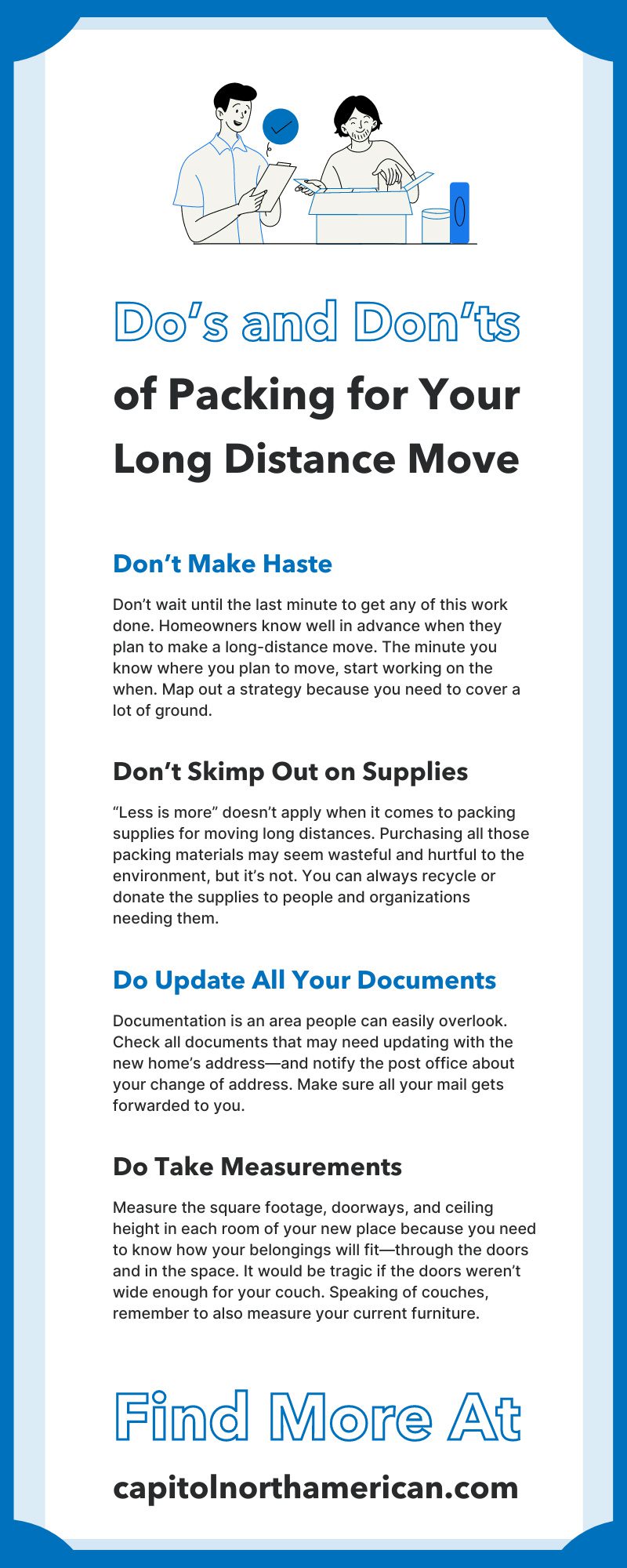
Moving is one thing. Moving long distances is a whole other thing. Homeowners must ensure they get things done correctly because turning around and coming back is not really an option. It’s possible, but it would be a huge headache. Don’t worry. We have the perfect tips to help all relocators know what to do and what not to do. Check out these do’s and don’ts of packing for your long-distance move.
Don’t Make Haste
Remember the golden rule: haste makes waste, and no one wants to deal with waste during a long-distance move. Don’t wait until the last minute to get any of this work done. Homeowners know well in advance when they plan to make a long-distance move.
The minute you know where you plan to move, start working on the when. Map out a strategy because you need to cover a lot of ground. It’s more than packing your belongings and renting a truck to drive to another city. Start jotting down all thoughts that come to your head about documentation changes, medical needs, grocery needs, and other areas you need to cover.
Don’t Skimp Out on Supplies
“Less is more” doesn’t apply when it comes to packing supplies for moving long distances. Purchasing all those packing materials may seem wasteful and hurtful to the environment, but it’s not. You can always recycle or donate the supplies to people and organizations needing them.
Get more supplies than you think you’ll need. There will be items popping up that you didn’t think about or even remember you own. If they have a place in the next home, you’ll need a box or container to store them in. Go overboard, and whatever you don’t need, you can always sell, donate, or save and store for another time.
Don’t Forget the List
Make a list of every task you need to complete leading up to the move. Have multiple lists if you need to stay more organized. Write everything down and make sure it’s in a place where you’ll remember it—preferably your phone.
Start with a list of things you need to conclude at your current home, then transition to tasks you need to do for the new spot. You can easily overlook to-do items like turning on the utilities. Make sure you’re no longer paying a bill associated with the previous home.
Don’t Overpack
Yes, more is always better when it comes to packing supplies, but we can’t say the same about belongings. You don’t want to bring everything on a long-distance move. A smaller load is always more manageable. Go through every item, room to room.
Decide what you need, what you don’t, and what you can purchase later. Then, start to form three piles. One pile for keeps, another for donation, and the final for trash. You might need to place colorful sticky notes on everything to visually represent each pile, as the chances of you immediately adding items to each pile as you move throughout the house are slim.
Don’t Be Unorganized
Don’t be one of those homeowners who just throw everything into one box and claim they’ll organize everything when they get to the new house. This strategy is terrible. Unpacking is already grueling work, and you don’t want to travel from room to room carrying a box of miscellaneous things.
Don’t mix and match items for the sake of speed. Be as specific as possible. Keep your clothes for each season separate. Kitchen items should not mix with any other room; the same rules apply to the rest of the house.
Do Update All Your Documents
Documentation is an area people can easily overlook. Check all documents that may need updating with the new home’s address—and notify the post office about your change of address. Make sure all your mail gets forwarded to you.
Missing your mail because it’s in your old home’s mailbox is no fun for anyone. Also, update your license and change of address. Standing in line at the DMV is not a good time, so get this task done as soon as possible. Go through all your paperwork at home and make sure you file sensitive information in a safe or locked cabinet instead of a box or general container.
Do Visit Your New Home
Looking at your new home once is not nearly enough. You need to visit your new place at least a hand full of times. Hopefully, it’s vacant, so you won’t need to worry about bothering the previous owners.
You need to see the space you’re moving into to properly visualize how everything will work. It’s always better to stay a step ahead so you don’t overwork yourself when it comes time to unpack.
Do Take Measurements
Measure the square footage, doorways, and ceiling height in each room of your new place because you need to know how your belongings will fit—through the doors and in the space. It would be tragic if the doors weren’t wide enough for your couch.
Speaking of couches, remember to also measure your current furniture. If you plan to replace some of the furnished appliances, measure their cutouts before making your purchases.
Do Purchase Insurance
Don’t skimp on movers’ insurance. Homeowners think they’re getting a steal when they don’t include it, but they’re not. The risk is too high; a lot could happen during transit.
Of course, you’ll pack your belongings with extra padding, but that doesn’t mean accidents don’t happen. Get the insurance and see what options are available to ensure your items’ safety.
Do Hire Us
Finally, you need to hire professionals to help you. More importantly, you need to hire us. We are the exact Nevada long-distance movers you want in your corner. At Capitol North America, we make sure your move goes smoothly by providing a stress-free moving process.
Knowing the do’s and don’ts of packing for a long-distance move is half the battle. Don’t fret! You’re well on your way to settling into your new home.


